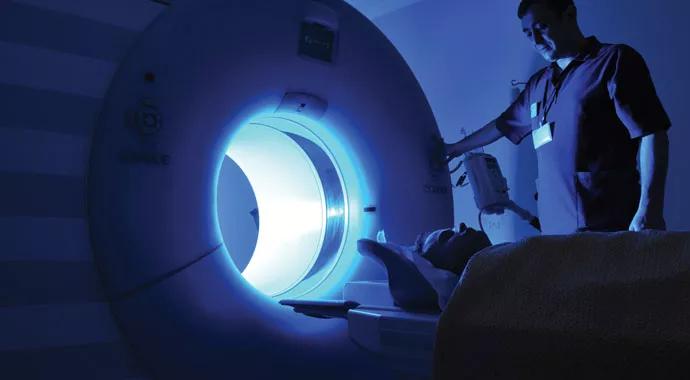New consensus statements shine light on imaging in overlooked subspecialty areas

Clinicians looking for evidence-based guidance on cardiovascular imaging in two challenging subspecialty areas, pericardial disease and cardiovascular complications of radiotherapy for cancer, had long been out of luck — until last fall. That’s when the American Society of Echocardiography, in conjunction with other major cardiovascular imaging societies, issued a pair of first-ever expert consensus statements on multimodality imaging in these areas.
Cleveland Clinic is a non-profit academic medical center. Advertising on our site helps support our mission. We do not endorse non-Cleveland Clinic products or services. Policy
“Clinicians have been requesting protocols and recommendations for imaging in pericardial disease for several years,” says Allan Klein, MD, who chaired the writing group of 15 U.S. authors for the guideline statement on pericardial disease. Dr. Klein, who is Director of Cleveland Clinic’s Center for the Diagnosis and Treatment of Pericardial Diseases and Vice President-Elect of the American Society of Echocardiography, was joined by four other Cleveland Clinic co-authors.
He explains that the guidelines — intended for use in primary care, emergency rooms, and rheumatology and cardiology subspecialty practice — aim to address poor awareness of the signs and symptoms of pericardial disease, inability to identify pericardial disease on imaging and inappropriate treatment duration for an aggressive condition.
“Clinicians who encounter pericardial disease need to understand its spectrum of presentation and stages, as well as how to identify the presence of inflammation and calcification, in order to provide timely, appropriate treatment,” says Dr. Klein, who answers questions about pericarditis and the new imaging guidelines in this video.
He describes the condition as an “equal-opportunity disease” affecting a wide spectrum of patients of all ages, ranging from teenagers and college students to patients with systemic lupus erythematosus or recent open-heart surgery.
Recognition of pericardial disease is enhanced by understanding its etiology and pathophysiology. The guidelines present recommendations for each of seven clinical syndromes of pericardial disease with differing etiologies. Tables, images and other resources are provided to aid identification of acute, recurrent and constrictive pericarditis at presentation and on imaging.
For example, symptoms of constrictive pericarditis — e.g.,dyspnea and leg/abdominal edema — are easily mistaken for those of other diseases. The guidelines offer a valuable pearl: Look at the neck veins.
“Have the patient stand or sit upright,” advises Dr. Klein, “and look for distended veins in the neck and an elevated jugular venous pulse. These are clear signs of constrictive pericarditis.”
Treatment must begin immediately, he adds, and the following six months are critical because anti-inflammatory therapy can be initiated if there is a subacute presentation with ongoing inflammation. If the presentation is chronic, the patient will be referred directly for pericardiectomy.
Once symptoms of acute, recurrent or constrictive pericarditis are recognized — including possible pericardial effusions and tamponade — imaging confirms the diagnosis and helps in staging the disease.
The guidelines note that echocardiography is generally the first-line method, with gadolinium-enhanced MRI or CT added in more complex cases.
All imaging modalities have their benefits and limitations, which are prominently outlined in an introductory table.
The guidelines are replete with images to aid recognition of the various forms, stages and etiologies of pericarditis as they appear on various imaging modalities. Images are accompanied by detailed guidance on issues such as the following:
• Which modalities to use and in what order
• How often to repeat the studies
• How to distinguish inflammation from pericardial fat
• How to treat the various forms of the disease after diagnosis
• When to advise surgery
• How long to use approved medications
An appendix aimed at sonographers, cardiologists and radiologists provides instructions on performing a detailed evaluation.
According to Dr. Klein, undertreatment of acute or recurrent inflammatory pericarditis is the leading reason for incomplete disease resolution. “By the time I see patients, many have had up to five or 10 recurrences,” he says.
These patients must be treated intensively with double or triple anti-inflammatory therapy — an NSAID (ibuprofen, indomethacin or aspirin) plus colchicine, and sometimes prednisone as well (for those with constrictive physiology) — for several months with a very slow weaning process over three to six months.
Treating intractable recurrent pericarditis with anti-inflammatory medications as mentioned above, as well as with DMARDs (azathioprine) or biologic agents (anakinra), may help reduce recurrent episodes. Surgery should be performed as a last resort.
Treatment should be individualized through systematic serial imaging to provide insight on efficacy and when to start tapering medications (i.e., steroids). “This is a new concept,” says Dr. Klein. “It’s the opposite of the old shotgun approach, where we gave medications for a week or two with rapid tapering and hoped for the best. Too often this caused a ‘yo-yo effect,’ with rapid tapering of prednisone causing a recurrence.”
Most patients with chronic constrictive pericarditis require surgical intervention. When fibrotic or calcium deposits in the pericardium cause constrictive pericarditis, patients can obtain immediate symptom relief with pericardiectomy. However, functional response and long-term outcome often depend on the extent of the pericardial deposits and extension of the thickened pericardium into the heart muscle.
While many cases can be treated appropriately outside a dedicated center for pericardial disease, immediate referral to an expert center is advised when a patient presents with advanced symptoms or doesn’t respond to therapy, in view of the condition’s high morbidity with many recurrences and mortality from advanced heart failure.
Within one or two days of an outpatient visit to Cleveland Clinic’s Center for the Diagnosis and Treatment of Pericardial Diseases, a patient will be seen by multiple subspecialists and undergo blood and advanced imaging tests with pericardial protocols, heart catheterization (if needed), appropriate medical treatment, and surgery, if necessary.
“The imaging, diagnosis and treatment of pericarditis are undergoing a renaissance,” Dr. Klein observes. “Our goal in developing these guidelines is that the disease become more widely recognized and appropriately treated so patients can feel better and get back on their feet.”
The other new expert consensus statement — on multimodality imaging for the evaluation of cardiovascular complications of radiotherapy in adults — reflects a fundamental shift in mindset that has accompanied the advent of more successful cancer therapies. Today, many patients survive their cancer only to develop — and in some cases die from— cardiovascular complications from their treatments.
“Our goal is to revisit our approach to cancer treatment using a thoughtful strategy that balances the benefits of the cure against potential cardiovascular complications of the treatment used to achieve it,” says Juan Carlos Plana, MD, Co-Director of Cleveland Clinic’s Cardio-Oncology Center and a staff physician in the Section of Cardiovascular Imaging. He was a member of the international author team that developed the consensus statement.
The effects of radiation to the chest for malignancies such as breast cancer and Hodgkin’s lymphoma include thickening and calcification of the pericardium, resulting in constrictive pericarditis, and accelerated atherosclerosis and fibrosis in big and small vessels, leading to ventricular stiffness and valvular heart disease.
Mortality associated with surgery in radiation-treated patients appears to be much higher than in other populations. A retrospective study of cancer survivors with radiation-induced heart disease who underwent cardiothoracic surgery at Cleveland Clinic found that 55 percent died over a mean follow-up of 7.6 years, as compared with 28 percent of a matched cohort undergoing similar procedures.
Strain imaging, an echocardiography technique pioneered at Cleveland Clinic and discussed in the guidelines, is poised to significantly enhance the ability to diagnose radiation induced cardiac dysfunction.
Using software that calculates the deformation of the heart, strain imaging provides clues about how well the heart is contracting. Strain imaging can identify a distressed heart much earlier than conventional assessment via ejection fraction.
“It allows us to recognize when the heart muscle has been damaged by the radiation,” Dr. Plana explains. “This is an important discussion to have with the patient, as it allows us to set realistic expectations for symptomatic improvement if cardiovascular surgery is performed.”
As a new subspecialty area, cardio-oncology is evolving fast. Among the many issues of interest are the best ways to prevent radiation therapy from damaging the heart in patients with breast cancer.
A variety of innovative techniques are used at Cleveland Clinic, including:
• The deep inspiration breath-hold technique to move the heart away from the radiation beam
• Whole-breast radiation in the prone position, allowing gravity to move the breast away from the heart
• Modulating the radiation dose to avoid the heart, including use of intensity-modulated radiation therapy
Dr. Plana emphasizes that treating heart disease in cancer survivors is best accomplished with a multidisciplinary team including cardiologists and thoracic and cardiovascular surgeons.
“The level of complexity is much higher than in other patients,” he notes. “Access to the chest may be challenging, because the tissues are thick and fibrotic. The risk of damaging structures with the scalpel is much higher. Calcifications may cause problems in clamping the aorta, requiring replacement of the aorta prior to valve surgery.”
Despite these challenges, Dr. Plana is hopeful the new imaging guidelines — and forthcoming guidelines on cardiac evaluation after chemotherapy whose development he is chairing — will help clinicians understand the urgency of examining patients who have survived cancer treatment.
Contact Dr. Klein at kleina@ccf.org and Dr. Plana at planaj@ccf.org.

Further acute testing not needed if ECG and high-sensitivity troponin are negative

Scott Cameron, MD, PhD, also brings wide-ranging research interests to bear

Pioneering U.K. vascular surgeon joins Cleveland Clinic

AHA statement is first comprehensive document on perioperative stroke reduction

Recognition reflects prioritization of long-term patient outcomes

Recommendations help distinguish exercise-induced remodeling from pathology

JACC review highlights factors unique to women, ways to tailor management

Pushing the envelope in ablation of atrial fibrillation, ventricular tachycardia